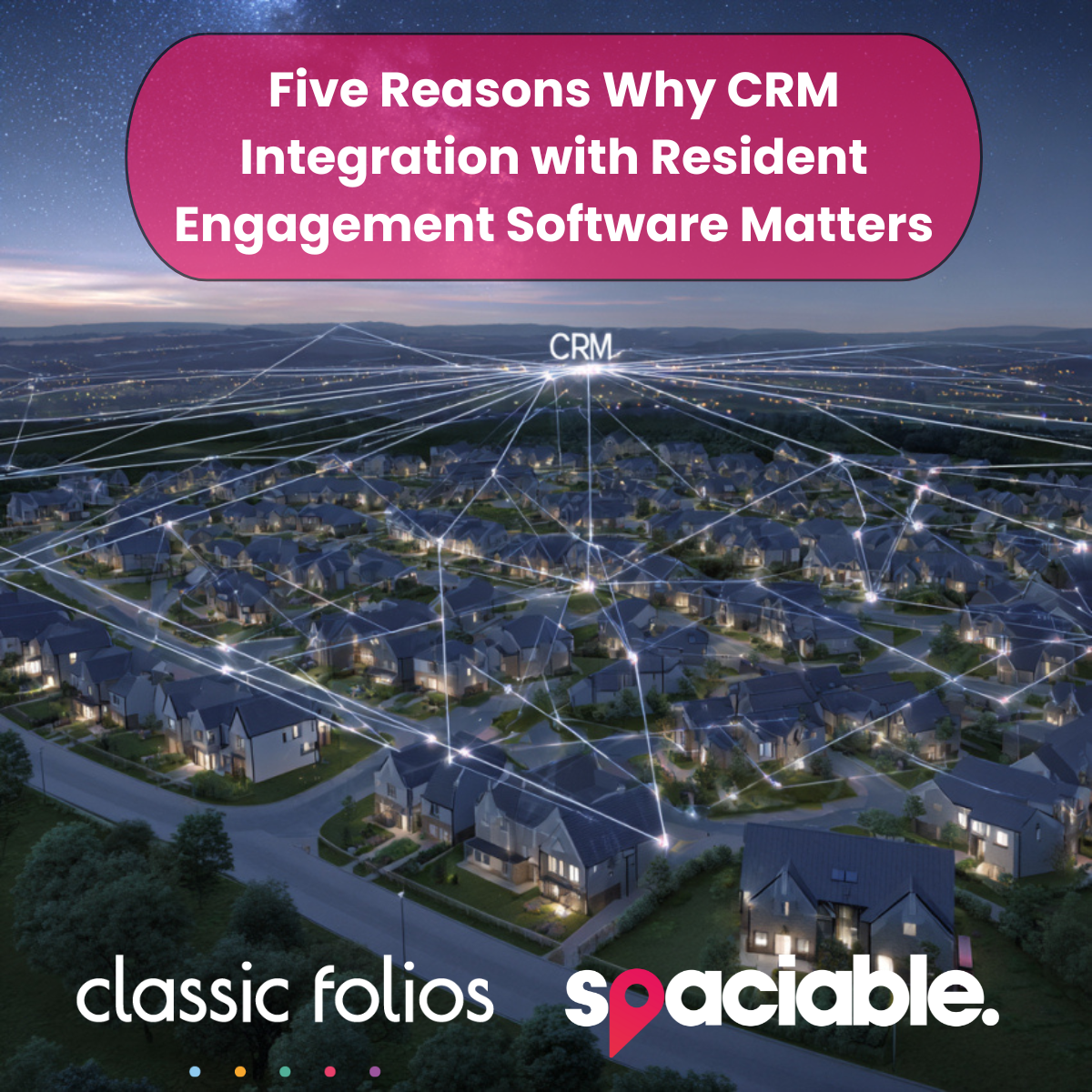Five Reasons Why CRM Integration with Resident Engagement Software Matters
Connected Systems, Connected Communities
The housing industry has often been labelled as a sector that was slow off the mark to digitise. However, there has been a strong movement in the PropTech arena over recent years, and now it would be hard to find a homebuilder who is not using at least one digital alternative for their processes. As Housebuilder Pro points out, ‘Embracing digital technologies has become imperative for staying competitive, enhancing efficiency, and delivering superior customer experiences.’
In this increasingly digitised housing landscape, a new challenge has arisen. It is no longer enough to choose digital tools that work well. You need to choose solutions that work well together.
For housing providers, the relationship between Customer Relationship Management (CRM) systems and resident engagement platforms is critical. Yet too often, these systems operate independently, leading to duplicated tasks, fragmented data, and slowing down both teams and tenants.
Integration isn’t just a nice-to-have, it has become the key to unlocking smarter, simpler resident experiences.
In this blog, we will outline five reasons why CRM integration with residential engagement is vital for successful property management, while providing advice on how to get the most out of the solutions you choose.
1. Eliminate Repetition, Elevate Efficiency
One of the most immediate benefits of integrating your CRM with your resident engagement platform is the reduction of duplicated effort. No more entering the same details into multiple systems or tracking down updates in disconnected workflows.
As MRI Software notes, ‘Integrated CRM solutions can be plugged into your Social Housing systems, enabling data to flow automatically into one, central, easy-to-read dashboard. Not only does this make life much easier for your team, it also reduces the risk of errors from duplicate manual data entry.’ That means fewer headaches, and more headspace for meaningful work.
With integration:
Resident data flows automatically across platforms
Tasks can be triggered and tracked via one-click processes
Less time is spent on admin – freeing up more time for productivity
2. One Source of Truth
When systems are disconnected, so is your information. Integration ensures a consistent, up-to-date view of resident and property data – whether you're logging a defect, updating a welcome pack, or issuing a service notification.
According to MRI’s Housing One platform: ‘Combining your data into a single, clear view ensures greater accuracy and insight.’ This enables better work allocation, more informed decisions, and ensures everyone’s on the same page.
This consistency helps you minimise errors, boost confidence, and keep communication crystal clear on both sides of the relationship.
3. Faster Service, Smarter Support
Integrated systems don’t just streamline information – they sharpen your service delivery. A case study from F-TEK highlights the time-saving benefit, when, ‘Employees no longer need to toggle between 10+ applications to find customer data.’ This also decreases confusion and errors, leading to a better service for the customer. F-TEK goes on to point out how, ‘Faster response times lead to higher productivity and improved employee satisfaction.’
When routine tasks move faster, housing teams can shift from reactive to proactive – and residents benefit from quicker, smoother service interactions.
Let’s face it: no one enjoys waiting for updates or repeating the same issue to multiple team members. CRM integration allows for:
Quicker turnaround on routine tasks
Smoother handovers across teams
Immediate, accurate responses for residents
4. One-Click Functionality that Works
One of the most tangible benefits of integration is one-click functionality. When processes that once required multiple systems are streamlined into a single platform, engagement becomes simple and intuitive.
As KPro Software puts it, ‘Getting this integration right can transform your back-end efficiency. The positive effects can boost every part of your business. Getting it right can also transform your customers’ experiences.’ Whether it’s logging a repair or sending out resident updates, integration empowers your team to work smarter, more efficiently and deliver a better service for your customers.
5. Better Journeys, Happier Residents
Integration isn’t just a tech fix. It’s a resident-first strategy. CRM-backed engagement ensures that each resident touchpoint is cohesive, helpful, and timely.
Housing Technology reports that, ‘CRM will provide a 360-degree view of each [resident], enabling faster call-handling, first-time resolution of issues, on-time payments and mobile working.’ That ‘360-degree view’ means stronger relationships built on reliability, clarity, and confidence.
With systems aligned, residents can:
Access updates in real-time
Submit issues and track responses with ease
Trust that their information – and their time – is being respected
This elevates the resident experience, transforming home users into loyal long-term customers and life-long advocates of your brand.
Spaciable specialises in creating connected ecosystems that work with your housing workflows – not against them.
To see what a fully integrated future looks like and to arrange a demo, please get in touch here.
CRM Integration Checklist for Housing Providers
Use this quick checklist to assess your current digital ecosystem and identify integration opportunities:
□ Resident data flows automatically between CRM and engagement platforms
□ Team members can access a single, up-to-date view of all resident interactions
□ Admin tasks are reduced with automated workflows and one-click functionality
□ Service requests and updates are tracked and actioned without switching systems
□ Residents receive faster, more accurate responses from your team
□ Communication is consistent, clear, and always up to date
□ Engagement tools work with your CRM to deliver a seamless resident journey





